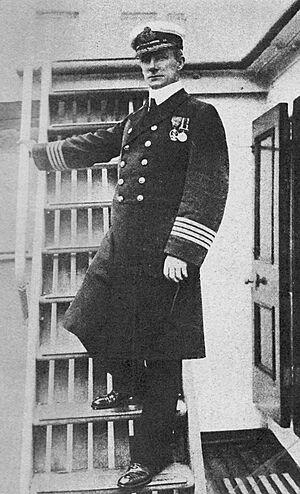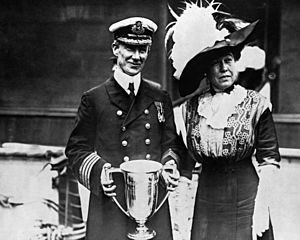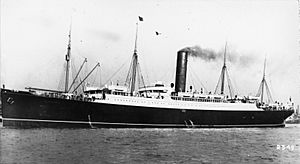Arthur Rostron facts for kids
Quick facts for kids
Sir
Arthur Rostron
|
|
|---|---|

Capt. A.H. Rostron while master of Carpathia in April 1912, at the time of rescuing Titanic survivors.
|
|
| Birth name | Arthur Henry Rostron |
| Born | 14 May 1869 Bolton, England, UK |
| Died | 4 November 1940 (aged 71) Chippenham, England, UK |
| Buried |
West End Parish Church, Southampton, England, UK
|
| Allegiance | |
| Service/ |
|
| Years of service | 1886–1931 (British Merchant Navy) 1893–1924 (Royal Naval Reserve) |
| Rank | Captain – RNR Commodore – Cunard |
| Commands held | RMS Pannonia RMS Carpathia RMS Carmania RMS Lusitania RMS Campania RMS Aurania RMS Mauretania RMS Andania RMS Saxonia RMS Berengaria |
| Battles/wars | World War I |
| Awards | Congressional Gold Medal |
Sir Arthur Henry Rostron (born May 14, 1869 – died November 4, 1940) was a brave British sailor. He is most famous for being the captain of the ocean liner RMS Carpathia. In 1912, his ship rescued the people who survived the sinking of the RMS Titanic in the middle of the North Atlantic Ocean.
Rostron was highly praised for how quickly and well he prepared his ship and crew for the rescue. He received many awards, including a special medal from the United States Congress. In 1926, he was made a Knight, which means he could use "Sir" before his name. He eventually became the top captain, or Commodore, of the Cunard shipping company before he retired in 1931.
Contents
Arthur Rostron's Early Life and Career
Arthur Rostron was born in 1869 in Sharples, a town near Bolton, England. He went to Bolton Grammar School and Bolton Church Institute. In 1884, when he was about 15, Arthur joined the Merchant Navy Cadet School Ship HMS Conway. This was a special school on a ship where young people learned to become officers in the merchant navy.
After two years of training, he became an apprentice with a shipping company in Liverpool. He worked on a large sailing ship called the Cedric the Saxon. In 1887, he became a second mate on another sailing ship, the Red Gauntlet. He then joined the Camphill.
On April 28, 1893, Arthur Rostron joined the Royal Naval Reserve (RNR) as a sub-lieutenant. The RNR was a group of trained sailors from the merchant navy who could be called upon to serve in the Royal Navy during wartime. He continued to work on merchant ships and passed exams to become an "extra master," which is a very high qualification for a ship's captain.
In 1899, Arthur Rostron married Ethel Minnie Stothert.
Working for Cunard Line
In January 1895, Rostron joined the Cunard Line, a famous shipping company. He started as a fourth officer on the ocean liner RMS Umbria. Over the years, he worked on many other Cunard ships, slowly moving up the ranks. He even took a break from Cunard to serve with the Royal Navy during a time of international tension.
Rostron returned to Cunard and became the first officer of the famous RMS Lusitania in 1907. Soon after, he was promoted to captain of his own ship, the Bresica. He commanded ships that sailed in the Mediterranean Sea, including his first passenger ship, the RMS Pannonia. On January 18, 1912, he became the captain of the passenger liner RMS Carpathia.
The Titanic Rescue: A Captain's Heroic Actions
The Carpathia was sailing its usual route between New York City and Fiume (now Rijeka, Croatia). Early in the morning of April 15, 1912, the ship received a distress signal. The message was from the White Star Line ocean liner RMS Titanic, which had hit an iceberg on its first voyage.
Captain Rostron was asleep when Carpathia's wireless (radio) operator, Harold Cottam, received the message. The Titanic had struck the iceberg around 11:40 p.m. and was asking for help. Cottam quickly ran to Rostron's cabin to tell him.
Racing to the Rescue
Captain Rostron immediately ordered the Carpathia to turn and race towards the Titanic's last known position. He knew there would be a lot of ice in the area, so he put extra lookouts on duty to help spot and avoid it. The Titanic was about 58 nautical miles (about 67 miles or 107 kilometers) away.
Rostron and his engineering team worked hard to get the Carpathia to go as fast as possible. They pushed the ship to 17.5 knots, which was three and a half knots faster than its normal speed! Even at this speed, traveling through dangerous ice, it took the Carpathia about 3.5 hours to reach the Titanic's location.
Preparing for Survivors
While racing, Rostron made sure the Carpathia was ready for the survivors. He turned off the ship's heating to make sure there was enough steam for the engines. He ordered his crew to get blankets, food, and drinks ready. He also told his medical team to be prepared for injured people. Crew members were placed in the hallways to calm passengers who were worried by the ship's increased speed and change in direction.
Captain Rostron gave 23 orders to his crew, and they carried out every single one before the Carpathia even arrived at the disaster scene. He praised his crew highly for their excellent work. Rostron was a very religious man. He is said to have prayed while giving orders. He later said, "I can only conclude another hand than mine was on the helm," meaning he believed God was guiding the ship.
Finding the Survivors
When Rostron thought they were getting close to the Titanic, he ordered green starburst rockets to be launched. These were to let the sinking ship, or its survivors, know that help was on the way. The Carpathia began picking up survivors about an hour after the first rocket was seen by those in the lifeboats.
The Carpathia rescued 705 people out of the 2,228 passengers and crew who were on board the Titanic. Sadly, at least one person died after being rescued. After talking with J. Bruce Ismay, a manager from the White Star Line and a Titanic survivor, Rostron decided to return to New York City to drop off the survivors.

Later, Captain Rostron gave his testimony at both the American and British investigations into the sinking of the Titanic. The Titanic survivors, including a famous passenger named Margaret Brown, gave Rostron a silver cup and a gold medal to thank him for his efforts. He also received many other awards, including the Congressional Gold Medal from the United States.
Rostron was highly praised for his actions during this terrible disaster by both the American and British inquiries.
Life After the Titanic Rescue
After the Titanic rescue, Captain Rostron continued to command the Carpathia for another year. He then transferred to other ships like the RMS Caronia (1904), RMS Carmania (1905), RMS Campania, and RMS Lusitania.
World War I Service
When World War I began, Rostron was captain of the RMS Aulania. His ship was taken over by the military to carry soldiers, and Rostron remained its commander. In 1915, Rostron and the Aulania were part of the Gallipoli campaign in Turkey. He was recognized for his good service during this time.
After the war, Rostron continued to command famous ships like the Mauretania and the Imperator (later renamed Berengaria). He was promoted to Captain in the Royal Naval Reserve in 1918 and received another honor, becoming a Commander of the Order of the British Empire.
Later Honors and Retirement
From 1924 to 1926, he served as a special aide to King George V. In July 1926, he was knighted, becoming "Sir Arthur Rostron." This was a great honor. He then became the Commodore of the Cunard fleet, which meant he was the most senior captain in the company.
Sir Arthur Rostron retired in May 1931. He wrote a book about his life at sea called Home from the Sea. When his old ship, the Mauretania, was being taken apart in 1935, Rostron was supposed to be on board for its last journey. However, he was too emotional to go and instead waved goodbye from the dock. He wanted to remember the ship as it was when he commanded it. Passengers used to call the Mauretania "The Rostron Express" because he was so good at keeping the ship on schedule.
Death
Sir Arthur Rostron became ill while visiting his daughter and developed pneumonia. He died on November 4, 1940, at the age of 71. His funeral was held at West End Parish Church in Southampton, where he is buried next to his wife, Ethel Minnie.
Portrayals in Titanic Films
Captain Rostron has been shown in several movies and TV shows about the Titanic:
- In the 1958 film A Night to Remember, he was played by Anthony Bushell.
- In the 1979 movie SOS Titanic, he was played by Philip Stone.
- In the 1996 TV drama Titanic, he was played by Terence Kelly.
- In the 1999 TV documentary The Titanic Chronicles, his voice was provided by John Cunningham.
Images for kids
See also
 In Spanish: Arthur Rostron para niños
In Spanish: Arthur Rostron para niños



